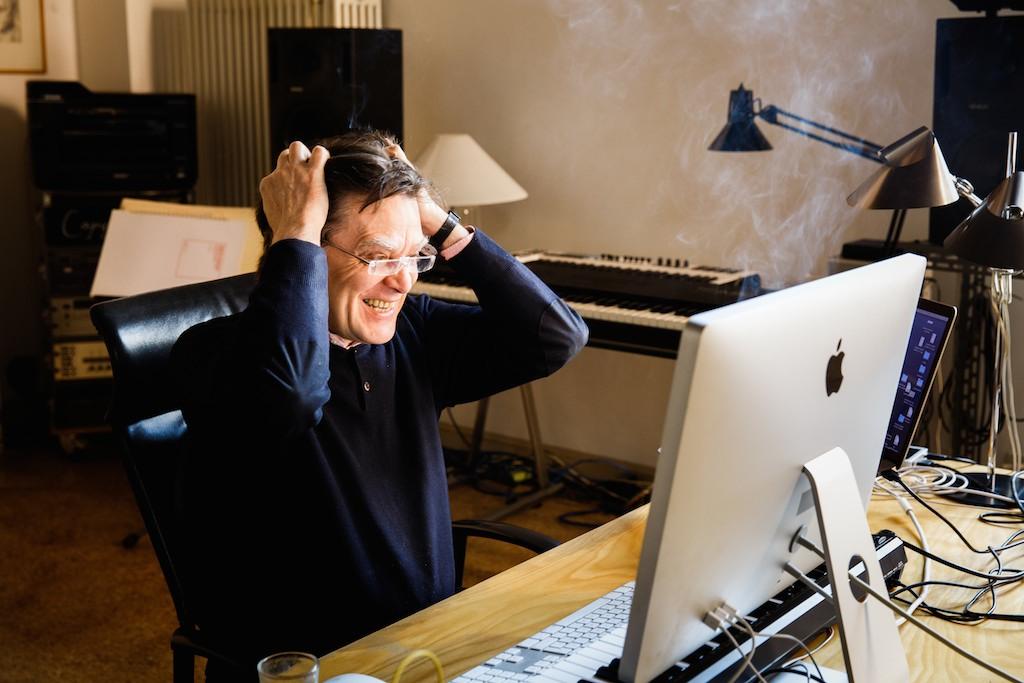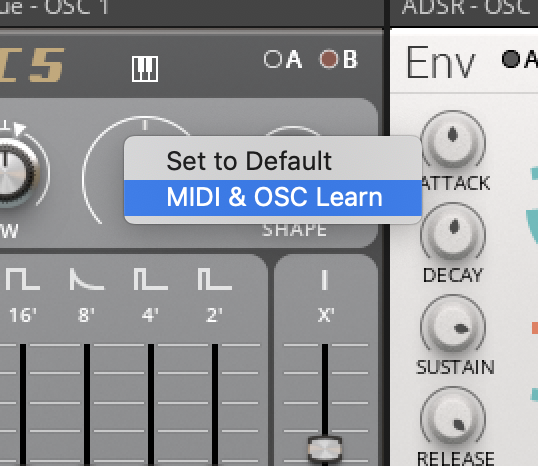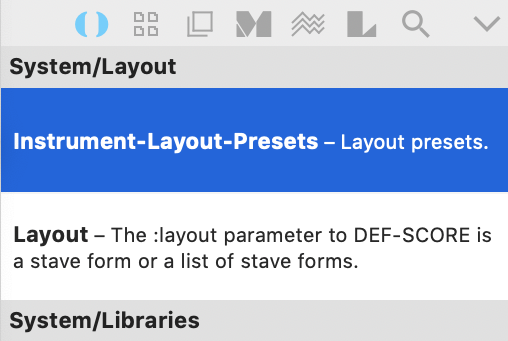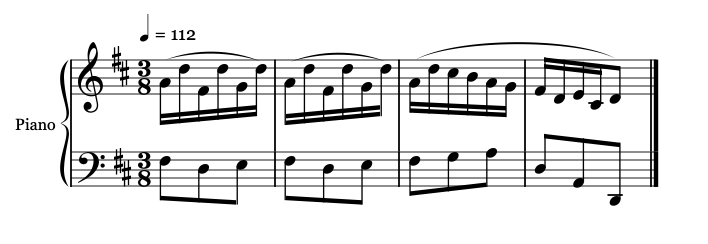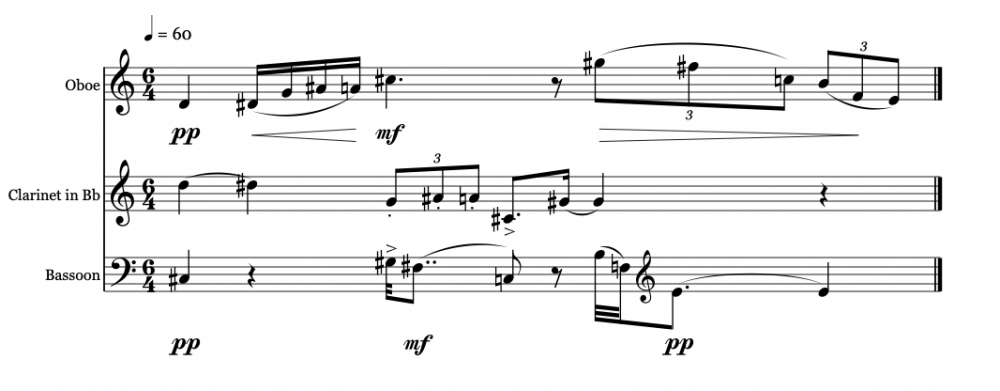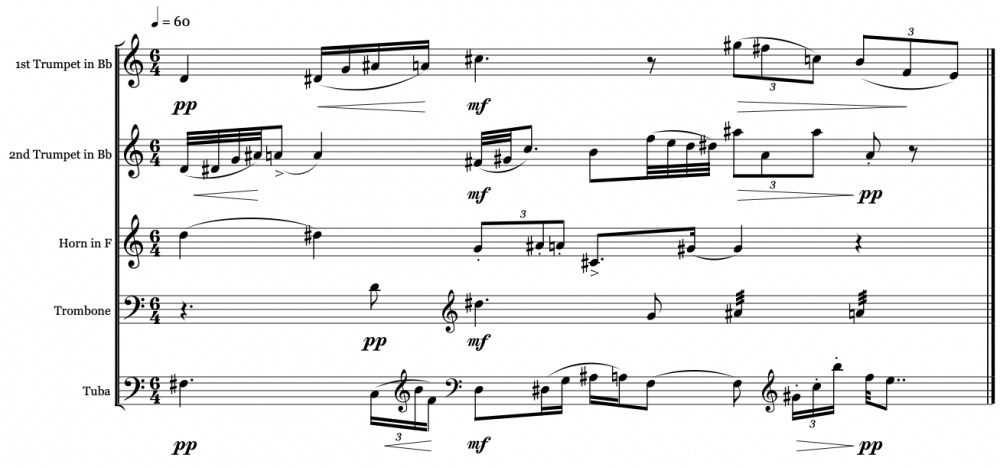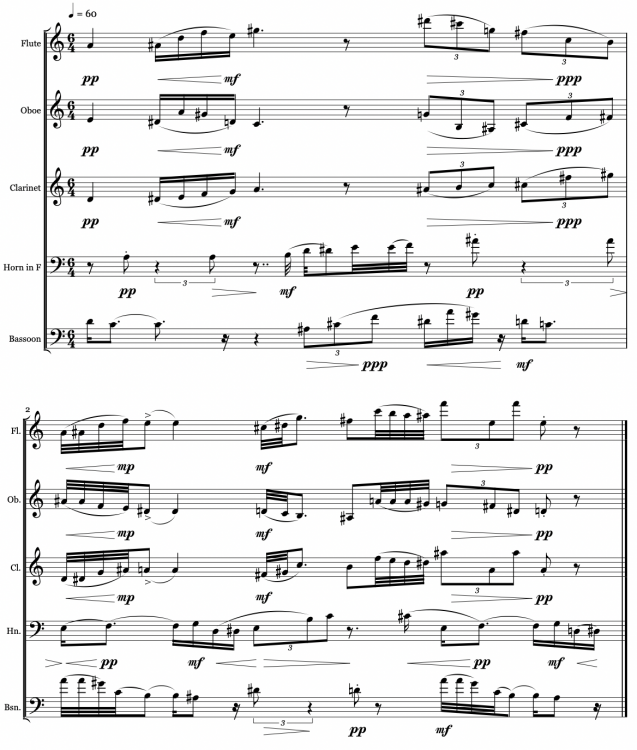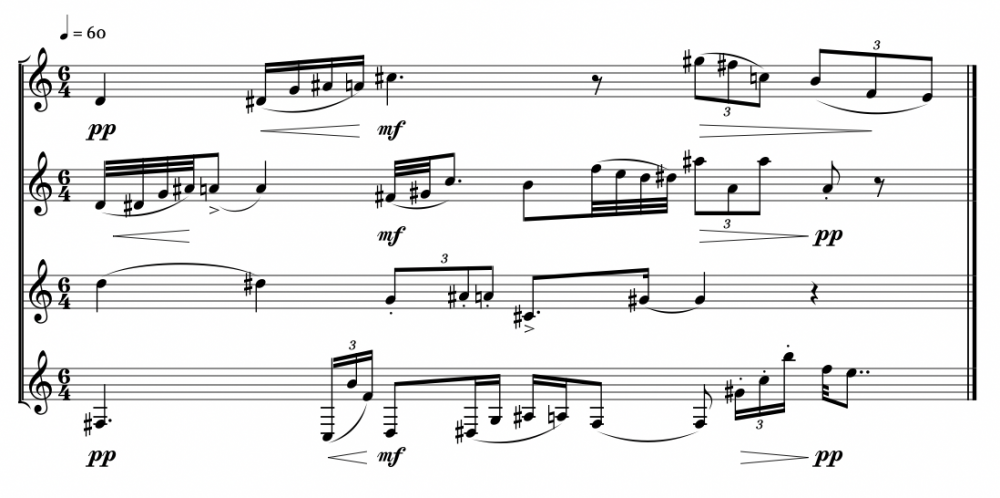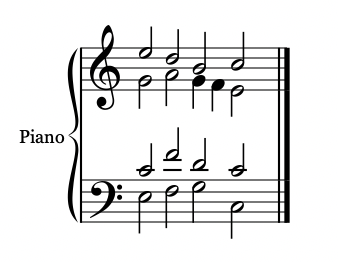-
Posts
2,891 -
Joined
-
Last visited
Content Type
Forums
Events
Store
Video Gallery
Everything posted by opmo
-
Dear Rangarajan, Here it is. OSC threads and Reaktor 6: 1. Expand the Reaktor-Drive.ens.zip file first. Reaktor-Drive.ens.zip 2. Move the Reaktor-Drive.ens file into the '~/Opusmodus/Instruments' directory, this will allow you to star the Reaktor form the Opusmodus app. 3. Add the 'OSC Threads.opmo' file into the Opusmodus Navigator. OSC Threads.opmo 4. Evaluate the DATA parameters. 5. Evaluate the SCORE. 6. Press START button in the Live Coding Instrument - you should hear a sound coming from your Reaktor instrument. 7. Now you are ready to run the OSC threads. You can end any thread at any time with END-OSC-THREADS or all threads with END-ALL-OSC-THREADS. Yes, the OSC-THREAD send the data to the given controller at the other end. Each message has two values, example: (0.04198588 4). The first value is the controller value, the second value is the time (interval - second or ratio). Best wishes, Janusz
-
New function: STOP-ALL-OSC-THREADS Fixed: Live Coding Instrument hanging note at Stop. Few document errors. Note: Select 'Check for Updates..." from Opusmodus menu.
-
First you need to define and link the thread IDs with the Reaktor controllers. Each Drive.ens controller (button or slider) should receive one ID thread message. In the Reaktor you can assign a OSC thread ID with a right mouse click on the controller selecting "MIDi & OSC Learn": You should send only one thread at a time. Stop the thread and trigger next one etc... The new function END-ALL-OSC-THREADS will destroy all OSC threads. Please note, you need to update your app first (1.3.24667) before you can use the new function. To do that simply select 'Check for Updates..." from Opusmodus menu. Tomorrow I will create a Drive.ens - for Reaktor 6 - with ID controllers already linked, as well a simple score for LCI to play with.
-
Good to see Rangarajan. This example should help. In this example I use the Reaktor "Drive.ens" from the Reaktor Blocks. OSC Threads.opmo To hear the OSC messages in action you need to create a score and send the midi messages to the Reaktor possibly on :port 0 and :channel 1. Best wishes, Janusz
-
Just replace the old "Load CLM Instruments.lisp" file with this one: Load CLM Instruments.lisp
-

resolved the new Def-Instruments errors..SOLVED
opmo replied to Andy's topic in Support & Troubleshooting
-

resolved the new Def-Instruments errors..SOLVED
opmo replied to Andy's topic in Support & Troubleshooting
Yes, every expression needs evaluation first. -
To make the direct access to your own Instrument-Sets programs from the Libraries pane you need to create a new folder with the name 'Def-Instrument-Sets' in the '~/Opusmodus/Def-Libraries' directory. This will be the place where you store your Def-Instrument-Sets instances and the files will be loaded at startup.
-
Display in the window instead in the Assistant panel. Example: Display in the Assistant pane: (ps 'gm :fl (list '((t d4 < leg eb4 < leg g4 < leg bb4 q. a4 marc t fs4 mf leg gs4 leg e. c5 e b4 t f5 leg e5 leg d5 leg eb5 3q bb5 > a4 > bb5 > e a4 pp stacc -e)))) Display in the window: (ps 'gm :fl (list '((t d4 < leg eb4 < leg g4 < leg bb4 q. a4 marc t fs4 mf leg gs4 leg e. c5 e b4 t f5 leg e5 leg d5 leg eb5 3q bb5 > a4 > bb5 > e a4 pp stacc -e))) :display :window) To open the last compiled score file in the window: (display-midi *last-score* :display :window) To display the last compiled score file in the window: (display-musicxml *last-score* :display :window) Check the Tools menu for the shout cuts and the contextual menu.
-
Here it is:
-
Looks like you are not using CLM therefore remove the 'Load CLM Instruments.lisp' form the Extensions folder, otherwise follow the instruction how to make the CLM work here:
-
Opusmodus version 1.3.24622 - support for second monitor and window for MIDI player and MusicXML display.
-

implemented HELP needed on Jazz Lines from fragments
opmo replied to JulioHerrlein's topic in Score and Notation
Function name: BIND-TO-INTERVAL in Opusmodus version 1.3.24622- 18 replies
-
- jazz
- jazz studies
-
(and 2 more)
Tagged with:
-
Free update for Opusmodus 1.3. users. It includes a support for a second screen and multi voice snippets. The new UNFOLD system opens up a whole new set of possibilities for the composer using OPUSMODUS. Additional library directory: 'Def-Instrument-Sets'. New functions: DEF-INSTRUMENT-SETS Use this function to define the instrument-sets with a given name. With named instrument-sets a composer can customise OPUSMODUS to reflect MIDI synthesisers or samplers which a studio system (inboard or outboard) might contain. The DEF-INSTRUMENT-SETS function is an essential companion to the PS function (PS stands for ‘Preview Score’ or, ‘Preview Snippet’). To create instrument-sets is fairly easy to do as it resembles the instrument setup from the DEF-SCORE instance. The instrument-set template: <instrument-name> (:layout <layout> :port <port> :channel <channel> :sound <sound-set> :program <program> :controllers <controllers> :pan <panning> :volume <volume>) To explain how it all works we will define new instrument-sets with two instruments. In our example we will use :oboe and :bassoon as our instrument names with a library name: my-inst. The next step we need to do is to select the corresponding instrument layout. The predefined layouts you will find in the ‘Instrument Layout Presets’ document in the System/Layout library: Examples: (def-instrument-sets my-inst :instruments (:group group :oboe (:layout oboe-layout :port nil :channel 1 :sound 'gm :program '(oboe) :controllers nil :pan (pan 0) :volume 92) :bassoon (:layout bassoon-layout :port nil :channel 2 :sound 'gm :program '(bassoon) :controllers nil :pan (pan -10) :volume 92) )) Here is how an instrument from a defined instrument-sets name might be entered into PS: (ps 'my-inst :oboe (list '((s a4 leg d5 leg fs4 leg d5 leg g4 leg d5) (s a4 leg d5 leg fs4 leg d5 leg g4 leg d5) (s a4 leg d5 leg cs5 leg b4 leg a4 leg g4 leg) (s fs4 leg d4 leg e4 leg cs4 leg e d4))) :bassoon (list '((e fs3 d3 e3) (e fs3 d3 e3) (e fs3 g3 a3) (e d3 a2 d2))) :key-signature '(d maj) :time-signature '(3 8 1) :tempo 112) You can define as many instrument-sets instances as needed. PS Use this function if you are looking for a quick preview of your score or when a snippet (especially for education) needs a full representation of the intended notation. The PS function name stands for ‘Preview Score’ or ‘Preview Snippet’. In the following examples we use the default instrument-sets library, defined in the ‘GM Instrument Sets.lisp’ file, which you will find in the Library panel. How to create your own instrument-sets library, you will find in the DEF-INSTRUMENT-SETS document. Instrument treble: (ps 'gm :treble (list '((s a4 leg d5 leg fs4 leg d5 leg g4 leg d5) (s a4 leg d5 leg fs4 leg d5 leg g4 leg d5) (s a4 leg d5 leg cs5 leg b4 leg a4 leg g4 leg) (s fs4 leg d4 leg e4 leg cs4 leg e d4))) :key-signature '(d maj) :time-signature '(3 8 1) :tempo 112) Instrument piano: (ps 'gm :p (list '((s a4 leg d5 leg fs4 leg d5 leg g4 leg d5) (s a4 leg d5 leg fs4 leg d5 leg g4 leg d5) (s a4 leg d5 leg cs5 leg b4 leg a4 leg g4 leg) (s fs4 leg d4 leg e4 leg cs4 leg e d4)) '((e fs3 d3 e3) (e fs3 d3 e3) (e fs3 g3 a3) (e d3 a2 d2))) :key-signature '(d maj) :time-signature '(3 8 1) :tempo 112 :title "G. Ph. Telemann, 12 Fantasie per clavicembalo TWV 33-n.1, 1732") Examples: The examples below demonstrate how quickly you can preview your progress at any stage of your work ie. voices, instrumentation etc… (setf p1 '(q d4 pp s eb4 < leg g4 < leg bb4 < leg a4 q. cs5 mf -e 3q gs5 > leg fs5 > leg c5 > b4 > leg f4 leg e4) p2 '(t d4 < leg eb4 < leg g4 < leg bb4 q. a4 marc t fs4 mf leg gs4 leg e. c5 e b4 t f5 leg e5 leg d5 leg eb5 3q bb5 > a4 > bb5 > e a4 pp stacc -e) p3 '(q d5 leg eb5 3q g4 stacc bb4 stacc a4 stacc e. cs4 marc s gs4 leg q gs4 -q) p4 '(-q. e d4 pp q. eb5 mf e g4 q bb4 trem a4 trem) p5 '(q. fs3 pp 3e c3 < leg b4 < leg f4 e d3 mf s eb3 leg g3 leg bb3 leg a3 e fs3 leg fs3 3e gs4 > stacc c5 > stacc b5 > stacc t f5 pp e.. e5) p6 '(q cs3 pp -q t gs3 marc e.. fs3 mf leg e c3 -e t b3 leg f3 q.. e4 pp) ) Please note how the list function is used to enclose the instrument voices. The number of voices in an instrument should not exceed the layout of a particular instrument. For example a piano uses a two staff notation therefore the input should be a two lists in a list (list (list right-hand) (list left-hand)). (ps 'gm :p (list (list p1) (list p6))) Instrument oboe, clarinet and bassoon: (ps 'gm :ob (list p1) :cl (list p3) :bn (list p6)) Brass Quintet: (ps 'gm :b5 (list p1 p2 p3 p4 p5)) DEF-UNFOLD UNFOLD The DEF-UNFOLD and UNFOLD function opens up a whole new set of possibilities for the composer using OPUSMODUS. It can prove a very powerful tool in defining methods (functions) from the outset, for a specific work or as a global index of your most used functions. To be able to store methods, processes and solutions and call them at anytime becomes a valuable resource for a composers workflow. This function is a companion to the UNFOLD function. (def-unfold m1 var (:pitch (pitch-variant x :variant '?)) dyn (:velocity (velocity-to-dynamic x)) ) (setf omn '(s bb4 p a4 h. db4 t gs4 mf fs4 c5 b4 q f5 e5)) To run the defined methods in a given omn-form sequence use the UNFOLD function: (unfold 'm1 '(var dyn) omn) Examples: (def-unfold m2 7 (:pitch (pitch-transpose 7 x)) -12 (:pitch (pitch-transpose -12 x)) ret (:all (gen-retrograde x :flatten t)) var (:pitch (pitch-variant x :variant '?)) gf (nil (gen-fragment '(3) '(3) x)) lrq (:length (length-rational-quantize x)) dyn (:velocity (velocity-to-dynamic x)) ls (nil (length-span '(6/4 6/4) x)) ob (:pitch (ambitus 'oboe x)) bn (:pitch (ambitus 'bassoon x)) hn (:pitch (ambitus 'french-horn x)) ) Please note that the number of methods within an instance can be much bigger than in the example above. Two bars of omn - opusmodus notation (setf mat '((q d4 pp s eb4 < leg g4 < leg bb4 < leg a4 q. cs5 mf -e 3q gs5 > leg fs5 > leg c5 > b4 > leg f4 leg e4) (t d4 < leg eb4 < leg g4 < leg bb4 q. a4 marc t fs4 mf leg gs4 leg e. c5 e b4 t f5 leg e5 leg d5 leg eb5 3q bb5 > a4 > bb5 > e a4 pp stacc -e))) Applying methods: (setf t1 (unfold 'm2 7 mat) t2 (unfold 'm2 '(-12 var ob) mat) t3 (unfold 'm2 'var mat) t4 (unfold 'm2 '(-12 gf lrq ls dyn ret var hn) t3) t5 (unfold 'm2 '(gf lrq ls dyn bn) t2) ) The result with a Wind-Quintet layout: (ps 'gm :w5 (list t1 t2 t3 t4 t5)) BIND-TO-INTERVAL The function BIND-TO-INTERVAL will bind (connect) a series of lists (patterns) to each-other with the given interval. Each transposition value is the sum of the last pitch in the list plus the given interval. The result of the process is a start transposition value for the next list. If rotate and variant options are used, the rotate process is the first followed by variant and finally the start transposition. In the example below the last pitch in the first list is g4, with binding interval 1 (semitone), therefore the start transposition value of the next list is gs4: (bind-to-interval '(1) '((s c4 d4 e4 g4) (s c4 d4 g4 e4))) => ((s c4 d4 e4 g4) (s gs4 bb4 eb5 c5)) Examples: (setf pattern '((s c4 d4 e4 g4) (s c4 d4 g4 e4) (s g4 e4 c4 d4) (s c4 d4 f4 g4) (s c4 d4 g4 f4) (s g4 f4 c4 d4) (s c4 d4 g4 f4) (s g4 gb4 f4 g4) (s g4 gb4 f4 a4) (s d4 f4 g4 a4) (s a4 g4 f4 d4) (s d4 f4 g4 c5))) In this example the binding intervals are 1 and 2 randomly selected: (bind-to-interval (rnd-sample (length pattern) '(1 2)) pattern) => ((s c4 d4 e4 g4) (s gs4 bb4 eb5 c5) (s d5 b4 g4 a4) (s b4 cs5 e5 fs5) (s g5 a5 d6 c6) (s d6 c6 g5 a5) (s bb5 c6 f6 eb6) (s f6 e6 eb6 f6) (s g6 fs6 f6 a6) (s bb6 cs7 eb7 f7) (s fs7 e7 d7 b6) (s cs7 e7 fs7 b7)) In the next example the binding intervals are 13 and -13 with random variant: (bind-to-interval (rnd-sample (length pattern) '(13 -13)) pattern :variant '?) => ((s c4 d4 e4 g4) (s fs3 a3 e3 d3) (s eb4 fs4 bb4 gs4) (s g3 f3 d3 c3) (s b1 a1 e1 fs1) (s g2 f2 bb2 c3) (s b1 a1 d2 e2) (s eb1 eb1 d1 cs1) (s d2 cs2 c2 e2) (s f3 d3 c3 bb2) (s b3 d4 e4 fs4) (s g5 bb5 c6 f6)) Here the binding intervals are 1, -1, 2 -2: (bind-to-interval '(1 -1 2 -1 2 -1 2) pattern) => ((s c4 d4 e4 g4) (s gs4 bb4 eb5 c5) (s b4 gs4 e4 fs4) (s gs4 bb4 cs5 eb5) (s d5 e5 a5 g5) (s a5 g5 d5 e5) (s eb5 f5 bb5 gs5) (s bb5 a5 gs5 bb5) (s b5 bb5 a5 cs6) (s c6 eb6 f6 g6) (s a6 g6 f6 d6) (s cs6 e6 fs6 b6)) (bind-to-interval '(1 -1 2 -1 2 -1 2) pattern :variant '?) => ((s c4 d4 e4 g4) (s gs4 f4 bb4 c5) (s b4 gs4 e4 fs4) (s gs4 bb4 cs5 eb5) (s d5 c5 a4 g4) (s a4 g4 e4 d4) (s cs4 eb4 gs4 fs4) (s gs4 a4 bb4 gs4) (s a4 bb4 b4 g4) (s fs4 a4 b4 cs5) (s eb5 c5 bb4 gs4) (s g4 e4 d4 a3)) Example with rotation: (bind-to-interval (rnd-sample (length pattern) '(1 2)) pattern :rotate '(1 2 1 2 1)) => ((s c4 d4 e4 g4) (s a4 f4 g4 c5) (s d5 e5 a5 fs5) (s gs5 cs5 eb5 fs5) (s gs5 fs5 cs5 eb5) (s e5 a5 g5 d5) (s e5 b4 cs5 fs5) (s g5 a5 a5 gs5) (s bb5 gs5 g5 fs5) (s g5 a5 d5 f5) (s g5 d6 c6 bb5) (s c6 d5 f5 g5)) PAN This function converts mixer panning values in the range from -100(L) to 100(R) into MIDI pan values. The centre position value in the PAN function is 0. Examples: (pan 0) => 64 (pan '(-12 0 12)) => (56 64 72) (pan '(-30 -10 10 30)) => (45 58 70 83) PAN in DEF-SCORE instrument instants definition: (def-score SQ (:title "String Quartet - VSL Show" :key-signature 'chromatic :time-signature (get-time-signature vln1) :tempo tempo :layout (string-quartet-layout 'violin1 'violin2 'viola 'cello)) (violin1 :omn vln1 :port 0 :channel 1 :sound 'vsl-violin-solo :program 0 :pan (pan -30)) (violin2 :omn vln2 :channel 2 :sound 'vsl-violin-solo :program 0 :pan (pan -10)) (viola :omn vla :channel 3 :sound 'vsl-viola-solo :program 0 :pan (pan 10)) (cello :omn vlc :channel 4 :sound 'vsl-cello-solo :program patches-vc :pan (pan 30)) ) PAN in DEF-INSTRUMENT-SETS instance: :string-quartet (:layout string-quartet-layout :port nil :channel '(1 2 3 4) :sound 'gm :program '(violin violin viola cello) :controllers nil :pan (pan '(-30 -10 10 30)) :volume 92) Multi Voice Snippet Select or place the mouse cursor at the end of the expression and press ⌘2. This snippet is very useful in sketching and testing the progress of your work ie. instrumentation, voice density etc… (setf p1 '(q d4 pp s eb4 < leg g4 < leg bb4 < leg a4 q. cs5 mf -e 3q gs5 > leg fs5 > leg c5 > b4 > leg f4 leg e4) p2 '(t d4 < leg eb4 < leg g4 < leg bb4 q. a4 marc t fs4 mf leg gs4 leg e. c5 e b4 t f5 leg e5 leg d5 leg eb5 3q bb5 > a4 > bb5 > e a4 pp stacc -e) p3 '(q d5 leg eb5 3q g4 stacc bb4 stacc a4 stacc e. cs4 marc s gs4 leg q gs4 -q) p4 '(q. fs3 pp 3e c3 < leg b4 < leg f4 e d3 mf s eb3 leg g3 leg bb3 leg a3 e fs3 leg fs3 3e gs4 > stacc c5 > stacc b5 > stacc t f5 pp e.. e5) p5 '(-q. e d4 pp q. eb5 mf e g4 q bb4 trem a4 trem) p6 '(q cs4 pp -q t gs4 marc e.. fs4 mf leg e c4 -e t b4 leg f4 q.. e4 pp) p7 '(-q e d4 leg eb4 h g4 mf leg q. g4 > -e) p8 '(s bb3 pp leg a3 h. db3 t gs4 mp fs3 < c5 < b3 q f4 marc e4) ) (list p1 p2 p3 p4) New window display: (display-midi *last-score* :display :window) (display-musicxml 'score :display :window) Changes to ‘Evaluate Score’ and ‘Last Score’ shortcut keys. Best wishes, Janusz
-
Such an example will be very useful indeed. Looking forward to see how you made it work. Best, J
-
The upcoming release will allow you to open display-midi, display-musicxml, graphs and snippets in a separate window. For any of you using second monitor this will be great addition to your work flow. Examples: (display-midi 'score :display :window) (display-musicxml 'score :display :window) Best, Janusz
-

implemented HELP needed on Jazz Lines from fragments
opmo replied to JulioHerrlein's topic in Score and Notation
The code is not very complex but it needs to work with pitch sequence, chords (last value) and omn-form sequence. The document will explain how it all works.- 18 replies
-
- jazz
- jazz studies
-
(and 2 more)
Tagged with:
-

implemented HELP needed on Jazz Lines from fragments
opmo replied to JulioHerrlein's topic in Score and Notation
Will be added to the next release: (setf pattern '((s c4 d4 e4 g4) (s c4 d4 g4 e4) (s g4 e4 c4 d4) (s c4 d4 f4 g4) (s c4 d4 g4 f4) (s g4 f4 c4 d4) (s c4 d4 g4 f4) (s g4 gb4 f4 g4) (s g4 gb4 f4 a4) (s d4 f4 g4 a4) (s a4 g4 f4 d4) (s d4 f4 g4 c5))) (pattern-series '(1 1 2 1 2 1 2) pattern) => ((s c4 d4 e4 g4) (s gs4 bb4 eb5 c5) (s cs5 bb4 fs4 gs4) (s bb4 c5 eb5 f5) (s fs5 gs5 cs6 b5) (s cs6 b5 fs5 gs5) (s a5 b5 e6 d6) (s e6 eb6 d6 e6) (s f6 e6 eb6 g6) (s gs6 b6 cs7 eb7) (s f7 eb7 cs7 bb6) (s b6 d7 e7 a7)) (pattern-series '(1 1 2 1 2 1 2) pattern :variant '(p p i r ri p p)) => ((s c4 d4 e4 g4) (s gs4 bb4 eb5 c5) (s cs5 bb4 fs4 gs4) (s bb4 gs4 f4 eb4) (s e4 fs4 cs4 b3) (s cs4 eb4 bb3 gs3) (s a3 b3 e4 d4) (s e4 eb4 d4 e4) (s f4 e4 eb4 g4) (s gs4 b4 cs5 eb5) (s f5 g5 a5 c6) (s cs6 gs5 fs5 eb5)) (pattern-series '(1 -1 2 -1 2 -1 2) pattern) => ((s c4 d4 e4 g4) (s gs4 bb4 eb5 c5) (s b4 gs4 e4 fs4) (s gs4 bb4 cs5 eb5) (s d5 e5 a5 g5) (s a5 g5 d5 e5) (s eb5 f5 bb5 gs5) (s bb5 a5 gs5 bb5) (s b5 bb5 a5 cs6) (s c6 eb6 f6 g6) (s a6 g6 f6 d6) (s cs6 e6 fs6 b6)) (pattern-series '(1 -1 2 -1 2 -1 2) pattern :variant '(p p i r ri p p)) => ((s c4 d4 e4 g4) (s gs4 bb4 eb5 c5) (s b4 gs4 e4 fs4) (s gs4 fs4 eb4 cs4) (s c4 d4 a3 g3) (s a3 b3 fs3 e3) (s eb3 f3 bb3 gs3) (s bb3 a3 gs3 bb3) (s b3 bb3 a3 cs4) (s c4 eb4 f4 g4) (s a4 b4 cs5 e5) (s eb5 bb4 gs4 f4)) with random (1 2) (pattern-series (rnd-sample (length pattern) '(1 2)) pattern) etc... (pattern-series (rnd-sample (length pattern) '(13 -13)) pattern :variant '?) Best, Janusz- 18 replies
-
- jazz
- jazz studies
-
(and 2 more)
Tagged with:
-

implemented HELP needed on Jazz Lines from fragments
opmo replied to JulioHerrlein's topic in Score and Notation
What is the input (sequence) and what would be the result, Example please.- 18 replies
-
- jazz
- jazz studies
-
(and 2 more)
Tagged with:
-
Example: (setf v1 '(h e5 d5 b4 c5)) (setf v2 '(h g4 a4 q g4 f4 h e4)) (setf v3 '(h c4 f4 d4 c4)) (setf v4 '(h e3 f3 g3 c3)) (def-score Cade (:key-signature 'chromatic :time-signature '(4 2) :tempo 80 :ignore-time-signature t :ignore-tempo t :layout (piano-layout '(v1 v2) '(v3 v4))) (v1 :omn v1 :channel 1 :sound 'gm :program 0) (v2 :omn v2) (v3 :omn v3) (v4 :omn v4) )
-

resolved XML Snippet "open with" context menu option
opmo replied to JulioHerrlein's topic in Suggestions & Ideas
First, you need to create a musicxml file from your score: (compile-score 'file-name :output :musicxml :file "file-name") Next: (musicxml-to-editor "file-name") To open the file in Finale: (musicxml-to-editor "file-name" :application "Finale") If the application name is not working you can use the identifier keyword with the bundle-identifier. For example the Sibelius 7.5 version identifier is "com.avid.Sibelius75" (musicxml-to-editor "file-name" :identifier "com.avid.Sibelius75") -
def-score is a score which is a finished work. For ideas I suggest to create a new file with your expressions. If you like to call some of your ideas algorithmically then you need to create a def-library. You don't need to care about a time signature or key signature, all that you do on a score level and not on a snippet level.
-
Snippet is just a snippet not a fragment of the score.
-
Please drop the file "v.aiff" into the ~/Opusmodus/Media/Audio directory. This file is a part of one of the CLM examples. soundfile: v.aiff
-
CLM Installation Common Lisp Music, by William Schottstaedt is a powerful sound synthesis language implemented in Lisp and C. CLM is essentially a toolbox for instrument building. Although it comes with a number of instruments ready to use, most composers use CLM to define their own instruments. For those of you that wish to dive into CLM sound synthesis system, I advise everyone to read this document carefully first. 1. Command Line Tools First you need to find out if "command line tools" are installed in your system. The C compiler is essential at the instrument compile and load time. Launch the Terminal, found in /Applications/Utilities/ To check if command line tools are installed run: xcode-select --version if installed you will see the below with the version found in your system, something like that: xcode-select version 1234 If command line tools are not installed run: xcode-select --install A software update popup window will appear that asks: “The xcode-select command requires the command line developer tools. Would you like to install the tools now?” choose to confirm this by clicking “Install”, then agree to the Terms of Service when requested. Wait for the Command Line Tools package download to complete, it’ll be about 130MB and installs fairly quickly depending on your connection speed. The installer goes away on its own when complete. Enjoy your new unix command line toolkit! 2. Load and Compile Instruments CLM system comes with a number of instruments which are a great starting point to see and hear CLM in action. Some of them are simple others are complex. Before you can run any of the instruments you must compile them first. To do that you need to open and evaluate a file "Load CLM Instrument.lisp", you will find the file in the CLM directory. This process will take a minute or so and it will create binary and dynamic library files for each of the instruments. The binary files will be saved in the bin directory and the library files will be saved in the libclm directory. After this process is completed you are ready to run the CLM Examples. If you wish to load your instruments at the startup of the app move the "Load CLM Instrument.lisp" file into the “~/Opusmodus/Extensions/“ directory. Thats all you need to do to make CLM system work in Opusmodus. Best wishes, Janusz
